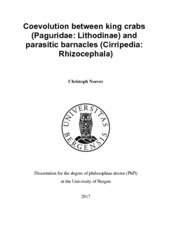Coevolution between king crabs (Paguridae: Lithodinae) and parasitic barnacles (Cirripedia: Rhizocephala)
Doctoral thesis

Åpne
Permanent lenke
https://hdl.handle.net/1956/16605Utgivelsesdato
2017-01-27Metadata
Vis full innførselSamlinger
Sammendrag
Molecular evidence has established that king crabs (Lithodinae) are gigantic hermit crabs without a gastropod shell to protect their abdomen. Secondarily, the abdomen has become calcified and flexed, in a crab-like manner. As a result, king crabs are superficially resembling brachyuran (true) crabs. Both king crabs and hermit crabs are parasitized by parasitic barnacles (Rhizocephala), which are an exclusively parasitic taxon belonging to the Cirripedia. Rhizocephalans are highly adapted to their parasitic lifestyle. Being irreversibly bound to their host, the parasites have extremely intimate relationships with their host taxa. In this thesis, the coevolutionary interplay between king crabs and parasitic barnacles has been investigated, to test, if the fascinating evolutionary origin of king crabs from a hermit crab ancestor can also be traced via the coevolution with their parasitic barnacles. To resolve the exact placement of king crabs within the hermit crabs and identify the closest extant relatives to the Lithodinae, a phylogenetic tree of hermit crabs and king crabs was constructed via Bayesian Inference and Maximum Likelihood analyses. To achieve this goal, multiple molecular markers of mitochondrial and nuclear ribosomal genes were utilized in combination with extensive taxon sampling. Further, a molecular phylogenetic tree of parasitic barnacles from numerous hermit crabs and king crabs was produced. The phylogeny of parasitic barnacles was subsequently linked to the phylogenetic tree of hermit crabs and king crabs, via individual hostparasite associations. Cophylogeny analyses of the dataset revealed that the parasites closely followed their hosts in a coevolutionary manner, where the speciation of a host lineage is accompanied by a parallel diversification of the parasite lineage. The evolution of king crabs was accompanied by two independent parasite lineages which followed the evolution of king crabs from a hermit crab ancestor. The host-parasite cophylogeny analyses strongly corroborated the phylogenetic placement of king crabs within the hermit crab family Paguridae. Hermit crabs were known to host a number of parasitic barnacle species, but only one species had been reported as a parasite of king crabs prior to this study. This parasite was supposed to parasitize a wide range of species, with a global distribution spanning all oceans. Detailed investigation of rhizocephalan parasites of king crabs revealed that the previously recognized single species constitutes of a rather large complex of cryptic species, each specialized to only one or few hosts. These cryptic species, of which two species new to science were described in this thesis, however, are difficult, or even impossible, to distinguish by morphology alone. Rhizocephala solely rely on their host for nutrition. Due to their parasitic lifestyle they have evolved a highly modified morphology compared to other crustaceans, lacking almost all arthropod features like segmentation, a centralized nervous system, any alimentary tract, or appendages. The adult morphology of the female parasite can be divided into two distinct parts: a sac-shaped reproductive body which is attached to the outside of the host, called the externa; and a trophic part situated inside the host, the interna, which has a root-like appearance. The interna infiltrates the inner organs as a complicated mycelia-like structure that spreads throughout the body of the host. Its location, hidden inside the host’s body, and highly structured morphology, makes this part of the organism difficult to study. Using state of the art X-ray micro computer tomography (MicroCT) and computer-aided 3Dreconstruction, the spatial organization of this root system inside the intact host was documented for parasites of king crabs and hermit crabs to investigate the parasite’s adaption to a highly changed morphology in their hosts, due to the process of carcinization in the Lithodinae. Results of this thesis are further used to evaluate the potential danger of the Northeast Atlantic red king crab population to become parasitized by a rhizocephalan parasite, with potential damaging effects for the fisheries industry. The red king crab, Paralithodes camtschaticus, is frequently parasitized by rhizocephalans in its native range, the North Pacific, but the introduced red king crab stock in the North Atlantic is rhizocephalan-free. The parasite grows an extensive system of green rootlets inside the crab, making infested king crabs unusable for marketing. The parasite further sterilizes its host, with a potential highly negative effect on population size and significant economic impact on the king crab fisheries.
Består av
Paper I: Noever, C., & Glenner, H. The origin of king crabs: hermit crab ancestry under the magnifying glass. Under review at the Zoological Journal of the Linnean Society. Full-text not available.Paper II: Noever, C., Olson, A., & Glenner, H. (2016). Two new cryptic and sympatric species of the king crab parasite Briarosaccus (Cirripedia: Rhizocephala) in the North Pacific. Zoological Journal of the Linnean Society, 176 (1), 3–14. The published version is available here: http://hdl.handle.net/1956/11882
Paper III: Noever, C., & Glenner, H. Host-parasite cophylogeny of Rhizocephala corroborates the origin of king crabs from hermit crabs. Manuscript. Full-text not available.
Paper IV: Noever, C., Keiler, J., & Glenner, H. (2016). First 3D reconstruction of the rhizocephalan root system using MicroCT. Journal of Sea Research,113, 58–64. http://hdl.handle.net/1956/12721